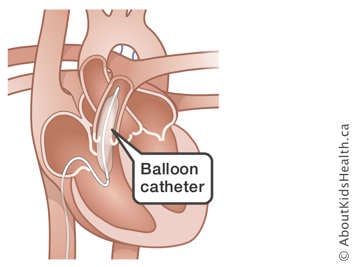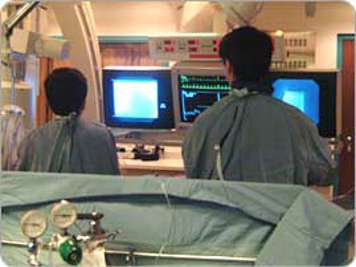Cardiac catheterization is a procedure in which a thin, flexible tube called a catheter is passed into the heart and its surrounding blood vessels.
Cardiac catheterizations can be used in two ways:
- to gather information (diagnostic catheterization)
- for treatment (interventional catheterization)
Through a tiny incision in the arm, neck, or groin, the catheter is inserted into a blood vessel (artery or vein) and directed into the heart by real-time X-ray imaging, or fluoroscopy. The catheters are used for blood sampling, pressure measurements, dye injection (angiogram), and to repair specific areas of the heart and the surrounding blood vessels.

Cardiac catheterizations are performed on people of all ages, from infants to adults with congenital heart disease. The procedures are done in the cardiac catheterization lab, which looks like a small operating room.
The length of hospital stay varies according to the type of cardiac catheterization procedure. Many catheterizations are performed on an out-patient basis.
Therapeutic or interventional catheterizations include:
- balloon atrial septostomy to enlarge an atrial septal defect
- balloon angioplasty to enlarge (dilate) a narrowed blood vessel
- valvuloplasty to open a heart valve that is abnormally obstructed
- device implantation to close a hole
- stent implantation to hold a blood vessel open
In many heart conditions, cardiac catheterizations can repair the heart without open-chest surgery.
What are the possible complications of cardiac catheterization?
Generally, cardiac catheterization is a low-risk procedure, but it is not risk-free. With any cardiac catheterization, there is a very small risk that the catheter may break through a blood vessel or the wall of the heart. To reduce the risk, the position of the catheter is carefully monitored by a type of X-ray called fluoroscopy.
Many risks depend on the specific type of procedure being performed. The cardiologist will explain these to you in detail before you consent to the procedure.
What is the pre-catheterization visit all about?
If your child is having cardiac catheterization, either as a test or as a treatment, you and your child will have a pre-catheterization visit at the hospital. Being prepared ahead of time helps both you and your child cope with the experience of being in the hospital.
You will come in a few weeks ahead of time to prepare for the procedure. If you are coming from out of town, you may come in a few days ahead. You will need to spend about half a day at the hospital.
Depending on the type of catheterization procedure your child needs, your child may need to have a number of tests, such as blood work, a chest X-ray, or an electrocardiogram (ECG). You will then meet with a nurse who will give you information about your child’s procedure and the care required after. You will also be able to meet with the doctor. Feeding instructions and arrival time for your child’s procedure day will be discussed with you during the visit.
Make sure you and your child have a normal breakfast before coming to the hospital. Since it is a long day, you may want to bring a snack and some toys for your child. You should also be sure to bring any necessary documents for your child, like health cards, hospital cards, and referral letters.
Important considerations before the catheterization

Let the hospital’s catheterization lab coordinator know before the day of catheterization if your child has a cold or cough, diarrhea, or signs of the flu, or has had any contact with someone who has a contagious disease like chicken pox or the measles. If this is the case, the procedure may need to be postponed.
Depending on the type of procedure and the age of your child, your child may need local anaesthesia, sedation, or general anaesthesia. The nurse or anaesthesiologist will explain how to prepare your child.
How long is the procedure?
The procedure takes two to three hours. Your child will then go to the recovery room for about one hour before returning to the cardiac unit. Depending on the procedure, your child may return to the inpatient unit or may remain in recovery room until ready for discharge home.
How long will your child stay in hospital?
Some children go home the same day after the procedure, while others need to stay overnight. Your child' s cardiologist will let you know how long your child needs to stay in the hospital.
What can you expect during recovery at home?
Some bruising and swelling may occur where the catheter was inserted (the catheterization site). You can give Tylenol to relieve any pain. If the pain lasts more than a few days, call your family doctor or paediatrician.
Keep the catheterization site clean and dry so that it will heal well. It must be covered by a bandage for 5 days after the catheterization. You will need to change the bandage once a day for each of those 5 days. If you notice that the bandage becomes soiled during the day, you should change it. This tends to happen more often with babies who are still in diapers.
Each time you change the bandage, look at the catheterization site to make sure that it is healing well. It is not unusual for the old bandage to have a spot of blood on it on the first day. The catheterization site itself should not be red or swollen. It may take a day or so for a scab to form over the area. If you notice any increased swelling, redness, or bruising, call your child' s paediatrician or family doctor.
If the catheterization site starts to bleed, apply pressure with a piece of clean gauze over the site for at least five minutes. Keep your child as quiet and still as possible. If the bleeding is excessive or does not stop in five minutes, call your child’s paediatrician or family doctor right away. If this is not possible, take your child to the closest emergency department as soon as possible.
Your child may complain of a sore leg on the side of the catheterization. If this continues for more than a couple of days, call your paediatrician.
Your child will not be able to have a tub bath for five days after the catheterization. A bath may increase the risk of infection at the catheterization site. You can give your child sponge baths or showers instead.
Your child' s cardiologist will let you know when your child may return to normal levels of physical activity.
Your child may need to take medication
Your child may need to take ASA or coumadin for several months after the procedure to prevent blood clots. You will be told how much before your child goes home. If your child has a cold or fever or is exposed to chickenpox during this six-month period, stop the ASA, treat the illness with Tylenol, and phone your family doctor or paediatrician who will tell you when to start the ASA again. If your child begins bruising easily, call your family doctor or pediatrician.
After treatment of an atrial septal defect or ventricular septal defect, your child will need antibiotics before and after dental treatments for 6 months after the procedure. These drugs help prevent a heart infection called infectious endocarditis. Your child’s cardiologist will tell you if this is needed for a longer time.
When does your child have to come back for a check-up?
Your child will be given an appointment to see the cardiologist several months after the procedure. In some cases, another catheterization will be booked so that the cardiologist can check up on how the heart looks after stent or other device placement.
For an atrial or ventricular defect, your child will be given an appointment to see the cardiologist one month after the procedure and will need follow-up appointments every six months for the first two years after the closure. Tests will be done to make sure that the defect is properly closed.